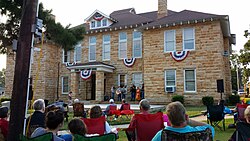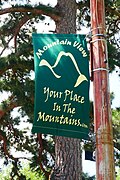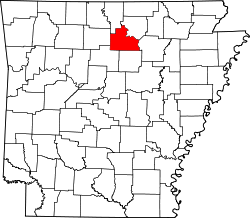Annual cultural events
Local festivals play an integral part in Mountain View's economy and culture, and the city is widely known throughout the country for its hospitality, uniqueness and relaxed pace of life. As such, thousands of people travel to Mountain View each year to attend one of these events and get a taste of Ozark Mountain culture. Often lodging must be secured a year in advance of the two major festivals. Some local estimates say that the city's population has grown to as much as 100,000 during past festivals, though this is likely an exaggeration. Average festival attendance tends to fall between 40,000 and 60,000.
In April, the city hosts the Arkansas Folk Festival. A highlight of this festival is an old-fashioned "home-town" parade, which brings out school bands, patriotic veterans groups, show horses, and decorated floats. Numerous folk craft vendors and many impromptu performances of live folk music are also part of the celebration.
During the spring, summer and fall, anytime the weather is nice, people from all over will gather in and around the courthouse square to play and listen to music. Bluegrass mostly, but a wide array of folk, swing, country and gospel can be heard performed by local townsfolk as well as pickers from hundreds of miles away. A few dedicated musicians play only the old-time tunes that have been passed down through generations.
During the fourth weekend of October, thousands attend the Arkansas Bean Fest and Great Championship Outhouse Races. Early Saturday morning, nearly one ton of pinto beans are cooked in large, antique iron kettles that are set up along the west side of the courthouse square. Promptly at noon, a couple thousand pounds of pinto beans and cornbread are served to the gathered crowd. The festival continues with the famous Outhouse Race. Local teams (and anyone who else who wishes to haul in an entry) push outhouses built on wheels (similar to a go-kart) in a series of races. The overall champion receives the coveted Golden Toilet Seat Trophy. Handmade crafts and folk music play an integral part in this festival as well.
Other local festivals included the Mountain View Bluegrass Festival, held in both mid-March and mid-November; An Old-Fashioned Fourth of July; and Mountains Music & Motorcycles in August. The town gets into the holiday spirit each year by lighting downtown buildings for Christmas open house events, and an annual Christmas tree lighting on the first Saturday in December.
The Ozark Folk Center plays host to several events throughout the year, including live concerts by well-known artist such as the Old Crow Medicine Show and Del McCoury, the Arkansas State Fiddle Championships, and workshops teaching banjo, dulcimer, and other folk crafts.











